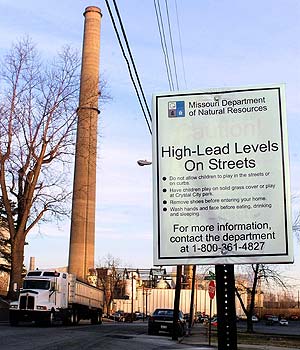A St. Louis County jury said a group of London insurers must pay Doe Run Resources for the cost of cleaning up lead contamination around six old lead milling sites in St. Francois County, but the amount the plaintiff will get is up in the air.
Marc D. Halpern, the plaintiff’s lead lawyer, said the final judgment “is expected to exceed $10 million.”
Last week the jury determined Doe Run’s remediation costs totaled $62.5 million, but that number goes down to roughly $5.7 million when the number of years the excess insurance policies were in place is factored in. The policies were in place for six years at three sites and for nine years at the other three sites.
Doe Run Resources, operating under the name St. Joseph Lead Co., bought the policies from London Market Insurers from 1952 until 1961. (London Market Insurers is listed on the Case.net docket as Certain Underwriters at Lloyd’s London.)
The $5.7 million figure also includes a 10 percent penalty in Doe Run’s favor, but it does not include attorneys’ fees. The jury said Halpern and his trial team are entitled to fees, but St. Louis County Judge Mark D. Seigel, who presided over the six-day trial, will determine the amount. Seigel also will calculate the final judgment.
“The jury acknowledged a larger sum of damages to Doe Run, but the Court’s prior rulings capped the potential damages. We plan to appeal those rulings,” Halpern, of Abelson | Herron in San Diego, said in an emailed statement.
Eleven jurors signed each verdict.
Carmody MacDonald attorney Kelley F. Farrell was on the defense team. She referred questions to Laura S. McKay and John T. Williams, both of Hinkhouse Williams Walsh in Chicago, who did not return messages by press time.
Doe Run Resources was on the Environmental Protection Agency’s national priorities list in 1992 for contamination at its Big River/Desloge site. The EPA investigated and in 1993 issued an order for Doe Run to remediate the site, the plaintiff’s attorney, Vincent Herron, of Abelson | Herron’s Los Angeles office, told the jury last month when the trial began. Other orders, both unilateral and by consent, were issued in the ensuing years for the other five sites: Bonne Terre, Elvins, Leadwood, National and Federal.
The contamination occurred as a result of wind and water erosion. Chat piles, or piles of ground-up waste from the mining process, tower roughly 300 feet at each of the sites, even though no chat was added to them since the 1930s. During that time, the process of separating lead from rock changed to a wet process, and a finer powdery substance, called tailings, was distributed in tailing ponds or dams. As the tailing ponds dried up, the substance hardened.
Defense attorney Williams told the jury during his opening that a key issue is whether the occurrence, or erosion, was expected. If it was, it’s not covered, he said.
“The wind was blowing, and the rain was falling, and that didn’t start in 1952; I think we can all agree on that,” he said.
He also said Doe Run can’t prove the damage caused by the erosion was unexpected. People in the mining industry knew in the early 1900s that lead waste is dangerous to fish, and Doe Run knew by 1926 of the potential for lead intoxication, Williams said.
The Doe Run name was in the news this summer when a jury in the city of St. Louis issued a verdict ordering the former owners of the Herculaneum lead smelter to pay 16 plaintiffs $358.5 million in actual and punitive damages. Doe Run Resources is the current owner of the smelter and is not responsible for the verdict.
The case is Doe Run Resources v. Certain Underwriters at Lloyd’s London, 2107CC-00613.


